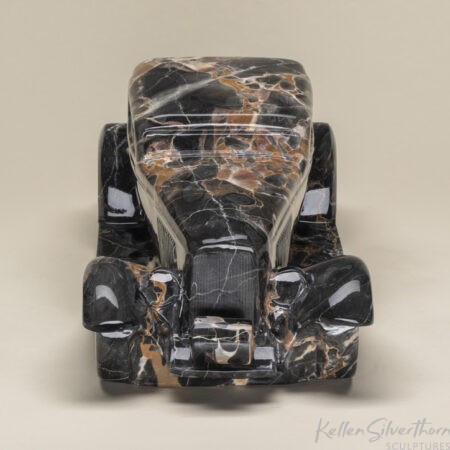Stone Cold Deuce – inspired by 1932 Ford hot rods
hover and click over individual sculpture photographs to enlarge
I was 14 years old when the movie American Grafitti hit the big screen. Though the movie’s story-line was more my parent’s generation, I didn’t have to mentally stretch much to lose myself in the depicted social scene of performance cars, high school friends, chasing girls, and rock n’roll music.

Crescendo scene from American Grafitti, Photo Credit, the Daily Drive
The supporting “hero” character, John Milner, has the fastest car in Modesto. Of course, it’s a stripped-down 1932 (thereby a Deuce), yellow Ford 5-window with a chopped roof. In my recollection, John is still a proponent of the long-serving Flathead Ford V8, which famously debuted with the 1932 Ford. John’s is a rear-guard battle, as by 1962 its been 13 years since Detroit started switching mainstream horses to the more advanced OHV (Overhead Valve) V8 engines. John’s alter-ego in the movie, played by a then-young Harrison Ford, pilots a Gasser-style 1955 Chevy, the inaugural year of the long-serving Chevy small-block OHV V8.

Stock 1932 Ford Flathead V8. Photo Credit to Hyman Ltd
My hometown of Victoria, British Columbia is a big wheel in the 1932-34 Ford hot rod world. Every three summers since 1998, Northwest Deuce Days have been hosted here. In recent editions, over a thousand 1932-34 Ford hot rods owners, and tens of thousands of spectators, gather for three days of celebration of these iconic Fords.
Indeed, one of my favorite activities at Victoria’s Deuce Days is peering into the engine bays to determine what engine motivates each creation. The diversity of both engines, and modifications, are impressive. Sure, small block Chevy’s and later GM LS motors power roughly half the attendees. But you can find just an example of each of the dozens of different post-war V8s from the Big Three.
Myself, I’m most pleased if there is still a Ford Flathead V8 in place in the engine bay. The Holy Grail is one with a period-correct OverHead Valve conversion on the flathead, such as Zora Arkus-Duntov’s “Ardun” head design.

Supercharged Flathead Ford V8 with Ardun OHV head conversion. Photo Credit to Torq Talk
So, nostalgia, civic pride, motorhead curiosity, and aesthetics all shepherded me towards a sculptural shout-out to the Hot Rod tribe. A street racer inspired Deuce Coupe seems appropriate. Make mine a chopped three-window in menacing black. Metal adornments include a polished aluminum front fuel tank, and twin exhaust.

Chopped three window. Photo credit to RK Motors

Fenderless three window. Photo Credit to Fine Art America and Dave Koontz
While in many automotive tribes, the thrust is for factory original, in the 1932-34 Ford hot rod tribe, the thrust is to make the result as individualized as possible. A Salute, then.

Heavily raked five-window. Photo Credit Good Guys / Fuel Curve
THE STONE
I’ve used the more traditional Portoro Extra Fino marble for several supercars from the 1960s (Roval Egg, and The Hen). That version of Portoro is deep black with flame-like gold veining. The Antique version of Portoro used in Stone Cold Deuce, has a more complex pattern. Again, there is gold veining over deep black, but also veining in cream, light yellow, burgundy, and even pink! In Antique, the black background is more varied in shade, than in Traditional. Both Portoro variants are from central Italy, near Florence.

Fender-less Five-Window. Photo Credit to Mecum Auctions / Visual Echo Photorgraphy

Photo Credit to macsmotorcitygarage.com






